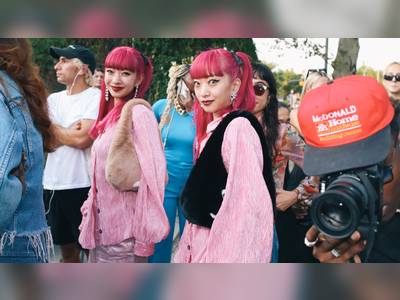A beautiful shade is what draws someone to a lipstick, says Anne Carullo, senior vice president of corporate product innovations at Estée Lauder. For someone to buy it again, it also has to have excellent texture and perform well, but it's the color that makes that initial sale, she says.
The industry recognizes seven basic color categories: pink to rose, mauve to rose, lilac to violet, plum to wine, peach to coral, beige to brown, and red.
Most lipsticks will fall within those color categories, but inspiration for the exact shade can come from anywhere, she says, picking up a copy of Wired magazine and noting what a rich shade of red was used for the typeface on the cover. She's taken color cues from textiles, food and paint.
"I can spot a winning color," Carullo says.
Makeup artist Laura Mercier says she finds herself reaching for a brown-rose shade time and time again. "The universal color I've been able to put on a lot of people is rose brown or brown rose," she says, noting that women with darker skin tones might lean toward a shinier version of the color.
You might see Clinique's Black Honey (a light red shade with blue undertones) on Lucky beauty editor Jean Godfrey-June's lips, but at first it took some convincing from a saleswoman. "When someone suggests a color you'd never wear, it can be a great thing," she says.
The fashion industry embraced coral shades for the upcoming spring, she says, but they can be harder to pull off. Godfrey-June suggests a wine or a berry with a little red and a little blue as compromises.
Allure's editor in chief Linda Wells encourages women to experiment with a range of lipstick colors - especially fuchsia - and then also be sure to carry a rosy brown. "That rosy brown is the shade that everyone is looking for all the time," she says.
"People are not that loyal to their lipsticks, but I think that if you find the shade that's right, you should carry it in your bag all the time. That doesn't mean there isn't room for three or four more," Wells says.
Red has a lot of power, says Jean Ford, co-founder and co-creator of Benefit Cosmetics. Before her career in beauty, Ford was a student teacher of second-graders. She recalls the principal of the school calling her into his office and asking why she always wore such bold lipstick.
"I would wear the brightest reddish-coral lipstick so students would pay attention. They'd have something to look at and see when I was talking," Ford says.
Mercier, a Frenchwoman, is getting a kick out of all the red lips she is seeing in the United States. "Red is back on trend. I'm laughing - not meanly but gently - because I've been told for years that American women are not interested in wearing red lipstick, especially if the French are, but they're wearing it now!"

Phil Oh’s Best Street Style Photos From the New York Fashion Week Spring 2023 Shows
This season New York Fashion Week has brought in a worldwide crowd of stars thanks to a packed season that even includes shows...












